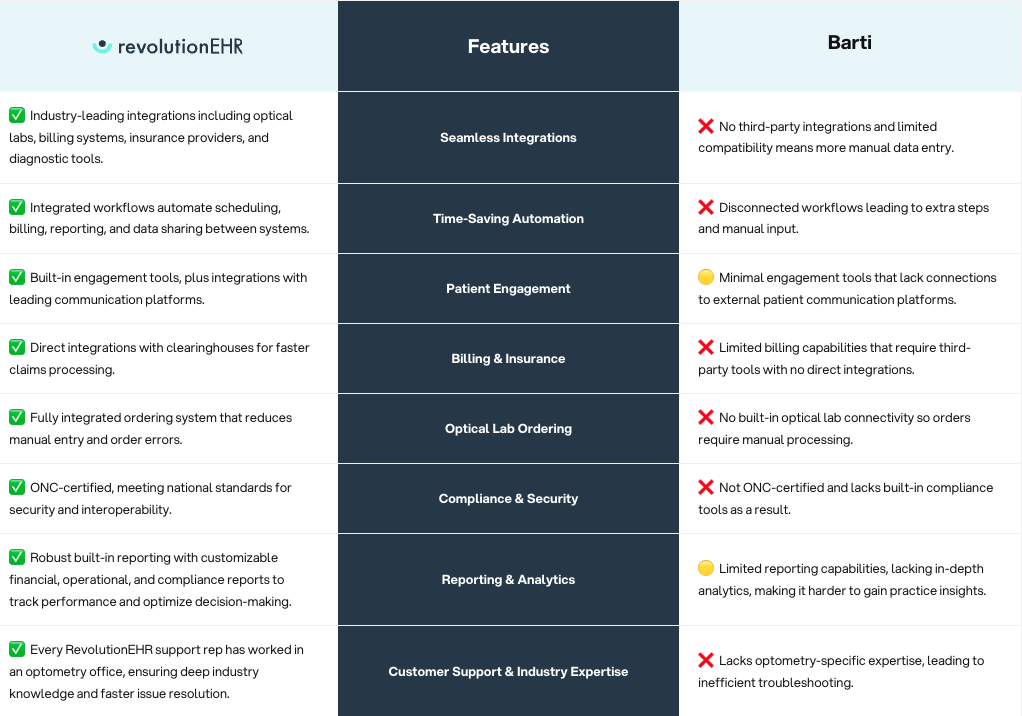Pricing varies, but most systems start around $200–$300 per month per provider. Total cost depends on features, number of users, and setup needs. See RevolutionEHR pricing.
Best EMR Software for Optometrists: A Practical Guide to Smarter Systems

- Remove the current class from the content27_link item as Webflows native current state will automatically be applied.
- To add interactions which automatically expand and collapse sections in the table of contents select the content27_h-trigger element, add an element trigger and select Mouse click (tap)
- For the 1st click select the custom animation Content 27 table of contents [Expand] and for the 2nd click select the custom animation Content 27 table of contents [Collapse].
- In the Trigger Settings, deselect all checkboxes other than Desktop and above. This disables the interaction on tablet and below to prevent bugs when scrolling.
What Makes an EMR Ideal for Optometry?
As eye care grows more complex and patient expectations rise, finding the best EMR for optometrists is important for business. With increasing demands on time, compliance, and care quality, the right system can make or break your day-to-day operations. Vision care providers need:
- Support for Optometry-Specific Needs
- Handles clinical tasks like documenting refractions and visual acuity, managing optical inventory, and integrating with diagnostic equipment.
- Built-In Compliance and Documentation
- Workflow Optimization Across the Practice
- Unifies scheduling, billing, and patient communication.
- Reduces redundancy and supports a smooth patient journey from check-in to follow-up.
In this guide, we've outlined what to look for in a platform that supports your workflow from the front desk to the exam room.
Top 5 Optometry EMR Features to Look For
1. Cloud-Based Access and Security
The right EMR shouldn't slow you down with server issues, clunky hardware, or limited access. Cloud-based systems let your team work from anywhere, whether reviewing charts after hours or managing multiple locations.
That flexibility also reduces the burden on your team. You don't have to manage servers, install updates, or worry about whether your data is backed up. The system takes care of that automatically, with built-in safeguards to keep information secure. And when your practice grows, it's easy to add new staff or locations without reworking your setup.
2. Customizable Exam Templates
No two optometry practices work the same. Your EMR should adapt to the way your team documents exams, builds care plans, and communicates with patients.
Customizable templates make it easy to adjust fields, reorder steps, and save reusable protocols. The best systems also support shared templates across providers and include tools to auto-fill common data points, so documentation stays consistent without slowing you down. You spend less time repeating tasks and more time staying focused on what matters in the moment.
3. E-prescribing and Lab Integrations
Look for an EMR that integrates directly with pharmacies, optical labs, and diagnostic equipment. When prescribing and ordering tools are built in, your team can send accurate prescriptions, place lab orders, and receive results without leaving the system.
Fewer clicks and less manual entry mean faster turnarounds, fewer errors, and a more streamlined experience for staff and patients.
4. Patient Portal
Your EMR should help patients stay connected outside of visits. Look for systems that support secure access to exam records, online scheduling, direct messaging, and easy payments.
Teleoptometry features (remote exams, digital imaging, and video consults) can improve continuity of care and reduce barriers for patients in rural or underserved areas. They also make it easier to follow up without adding to your team's workload.
5. Reporting and Analytics
You can't improve what you can't see. The right EMR software should make it easy to track key metrics like appointment volume, no-shows, Rx conversions, and recall performance across your practice.
It should also give that data meaning, helping you spot trends and areas you can improve. With clean, contextual reporting, you can make smart adjustments without losing focus on patient care.
Best EMR Software Options for Optometrists
Now that you know what to look for, here's a look at some of the most widely used EMRs in optometry. Each offers different features, integrations, and workflows. Use this overview to compare options and find the right fit for your practice.
RevolutionEHR
Designed exclusively for optometry, RevolutionEHR is a cloud-based platform that combines clinical tools, patient communication, billing, inventory, and reporting in one system. It’s widely used across solo and multi-location practices and integrates with a broad range of optical devices and partners.
Eyefinity EHR
Eyefinity provides a cloud-based platform for managing clinical and administrative tasks in optometry. It supports core workflows like charting, scheduling, and billing, with additional features to help practices stay efficient and patient-focused.

Compulink Healthcare Solutions
Formerly Compulink Advantage, this platform offers optometry- and opthalmology-focused EMR and practice management tools with a strong emphasis on customization. Practices can tailor workflows, documentation, and optical retail features to fit their unique setup.
Crystal Practice Management
Crystal provides EHR and office management tools for optometry practices, with options for cloud or local hosting. It covers core functions like charting, scheduling, and billing, and supports integration with common diagnostic equipment.
Barti
Barti is a cloud-based EHR for eye care practices that combines practice management and patient communication in one interface. It emphasizes automation and ease of use, offering a more streamlined option for smaller or newer practices aiming to simplify daily workflows.

iTRUST
iTRUST is built for optometrists who want to automate more of their day without adding complexity. From claims to communication to telehealth, it's designed to move routine tasks out of your way so you can stay focused on patients.
Why Optometrists Choose RevolutionEHR
Choosing the right EHR means finding a system that supports how you work today and scales with you tomorrow. With RevolutionEHR, you get a platform shaped by the needs of eye care professionals and designed to meet the demands of daily practice.
- Built exclusively for eye care. From clinical workflows to optical ordering, every feature is designed for optometrists.
- Seamless integration with tools and labs. Connect directly to diagnostic equipment, optical labs, billing systems, and more.
- Scalable for any practice size. Whether you're solo or managing multiple locations, RevolutionEHR adapts with you.
- Continuous updates and support. Regular improvements and dedicated guidance help your team stay efficient and focused.
As Dr. Nathan Lighthizer of NSUOCO put it:
“RevolutionEHR offered everything we were looking for. It has the structure and support we need, while giving us the flexibility to keep growing and adapting.”
Your optometry practice deserves an EHR that works as hard as you do. Request a demo to see how RevolutionEHR can support your goals.



